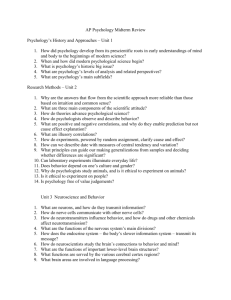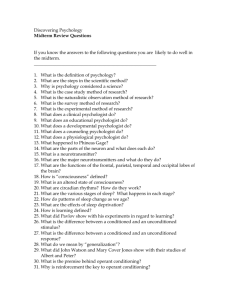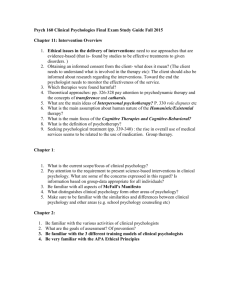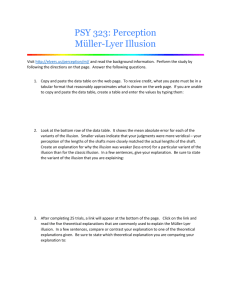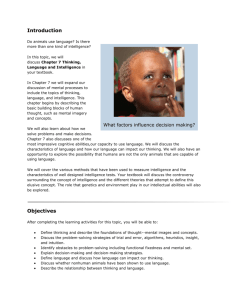PsychSim 5
advertisement
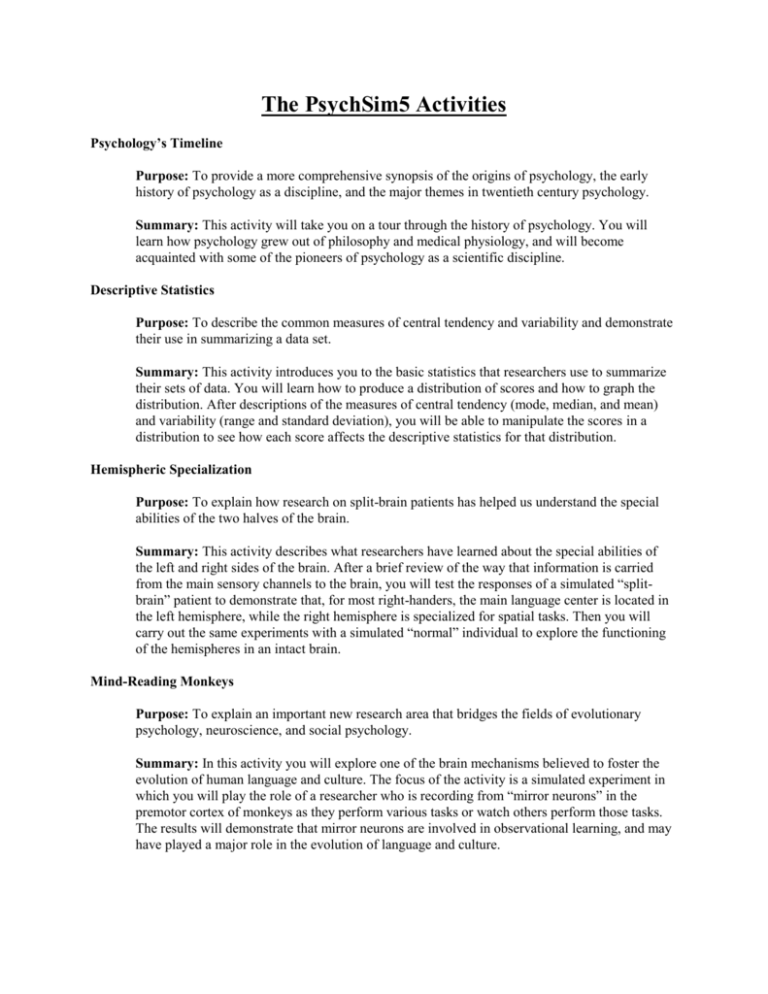
The PsychSim5 Activities Psychology’s Timeline Purpose: To provide a more comprehensive synopsis of the origins of psychology, the early history of psychology as a discipline, and the major themes in twentieth century psychology. Summary: This activity will take you on a tour through the history of psychology. You will learn how psychology grew out of philosophy and medical physiology, and will become acquainted with some of the pioneers of psychology as a scientific discipline. Descriptive Statistics Purpose: To describe the common measures of central tendency and variability and demonstrate their use in summarizing a data set. Summary: This activity introduces you to the basic statistics that researchers use to summarize their sets of data. You will learn how to produce a distribution of scores and how to graph the distribution. After descriptions of the measures of central tendency (mode, median, and mean) and variability (range and standard deviation), you will be able to manipulate the scores in a distribution to see how each score affects the descriptive statistics for that distribution. Hemispheric Specialization Purpose: To explain how research on split-brain patients has helped us understand the special abilities of the two halves of the brain. Summary: This activity describes what researchers have learned about the special abilities of the left and right sides of the brain. After a brief review of the way that information is carried from the main sensory channels to the brain, you will test the responses of a simulated “splitbrain” patient to demonstrate that, for most right-handers, the main language center is located in the left hemisphere, while the right hemisphere is specialized for spatial tasks. Then you will carry out the same experiments with a simulated “normal” individual to explore the functioning of the hemispheres in an intact brain. Mind-Reading Monkeys Purpose: To explain an important new research area that bridges the fields of evolutionary psychology, neuroscience, and social psychology. Summary: In this activity you will explore one of the brain mechanisms believed to foster the evolution of human language and culture. The focus of the activity is a simulated experiment in which you will play the role of a researcher who is recording from “mirror neurons” in the premotor cortex of monkeys as they perform various tasks or watch others perform those tasks. The results will demonstrate that mirror neurons are involved in observational learning, and may have played a major role in the evolution of language and culture. 2 The PsychSim Activities Cognitive Development Purpose: To describe Piaget’s theory on the growth of intelligence and simulate the performance of three children of different ages on some of Piaget’s tasks. Summary: After presenting background information on Jean Piaget, this activity explains some of the basic concepts of his theory, including schemas, operations, and assimilation/accommodation. Next, Piaget's stages of cognitive development are described and illustrated with examples. In the last segment, you act as the experimenter, testing 4-, 7-, and 13year-olds on Piaget's conservation and seriation tasks. The Auditory System Purpose: To explain how we hear and how the physical nature of the sound wave determines the quality of the sound experience. Summary: This activity covers the characteristics of sound that are important for hearing, and describes the structure of the ear and auditory pathway. You will be asked to locate the parts of the ear on a drawing. The activity simulates the transmission of a sound wave through the outer, middle, and inner ear and shows how the cochlea converts the mechanical energy to neural impulses. Next, it explains the concepts of frequency, amplitude, and waveform and shows how these aspects of the sound wave are related to the experience of pitch, loudness, and timbre. Visual Illusions Purpose: To demonstrate and explain four well-known visual illusions. Summary: This activity offers the opportunity to test your susceptibility to four famous visual illusions. In the Müller-Lyer, Ponzo, Horizontal-Vertical, and Poggendorf illusions you will be asked to adjust the length or position of one part of the stimulus in order to match the apparent length or position of another part. Your results will be displayed and interpreted. Your Mind on Drugs Purpose: To describe the basic types of psychoactive drugs and the neural mechanisms of drug action. Summary: In this activity you will explore the behavioral effects of some common drugs that influence the brain—producing changes in our arousal level, our mood, our perception of our environment, and our actions. EEG and Sleep Stages Purpose: To describe the five stages of the sleep cycle and the electroencephalograph (EEG). Summary: This activity provides an explanation of physiological recording of electrical potentials from the scalp and their relationship to levels of consciousness and sleep, and is followed by a simulation of one night of recordings from a sleep laboratory, illustrating the normal sleep cycle, REM sleep, and the relationship between REM sleep and dream reports. The PsychSim Activities 3 Operant Conditioning Purpose: To demonstrate some principles of behavior control through the manipulation of reinforcement. Summary: This activity describes a form of learning called operant conditioning—learning from the consequences that follow our actions. The concept of reinforcement as illustrated with examples from everyday life, while the value of controlled reinforcement schedules is demonstrated in a simulated experiment showing rat bar-pressing behavior under four different schedules of reinforcement. Iconic Memory Purpose: To demonstrate some aspects of sensory register. Summary: This activity simulates Sperling’s classic experiments on the duration of visual sensory memory. You will see nine random letters flashed in a 3 x 3 matrix, and will attempt to recall the letters under three conditions: free-recall, cued-recall, and delayed cued-recall. Your results will be compared to Sperling’s finding of rapid decay of the visual “icon.” My Head Is Spinning Purpose: To demonstrate thinking with verbal concepts and mental images, using the concept of mental rotation. Summary: This activity provides some background information about thinking with verbal concepts vs. thinking with mental images. The issue of mental rotation is introduced and explained with reference to the classic studies by Shepard and colleagues. You will participate in a simulated experiment involving mental rotation of the letter “R” in the picture plane. Your results will be graphed and compared to the pattern of results from Cooper and Shepard (1973). Get Smart Purpose: To explain the multidimensional nature of intelligence and demonstrate some tasks used to measure intelligence. Summary: In this activity you will explore the concept of intelligence and some of the methods of measuring intelligence. Along the way, you will try your hand at performing a few of the tasks and answering some questions typically found on intelligence tests. Hunger and the Fat Rat Purpose: To demonstrate the role of the hypothalamus in the control of eating behavior in rats. Summary: This activity provides a simulated experiment on weight regulation in rats. After a brief review of the methods of brain research involving electrical stimulation and destructive surgery, you will examine the effects of stimulating or destroying two different regions of a rat’s hypothalamus. The results will be graphed in terms of the rat’s daily food intake and body weight, illustrating the role of the hypothalamus in the regulation of eating and weight control. 4 The PsychSim Activities Expressing Emotion Purpose: To examine facial expressions and the underlying nonverbal messages they may convey. Summary: In this activity you will learn about the role of facial expressions in the nonverbal communication of emotion. Then we’ll put you in control of a cartoon-type face and test your skill in manipulating its facial muscles to form particular emotional expressions. This will help you learn the facial cues associated with each primary emotion. Helplessly Hoping Purpose: To explain the research basis for the concept of learned helplessness. Summary: In this activity you will explore the importance of a sense of personal control over the events in your life. You’ll participate in a simulated experiment on learned helplessness in dogs, and then consider how the results might apply to the behavior of people trapped in unpleasant situations. Mystery Client Purpose: To review and test understanding of the classification of behavioral disorders. Summary: This activity will be most useful to you after you have read the text material on psychological disorders. In this activity you’ll take the role of a consultant called in to provide a second opinion on several clients with disorders, based only on the information contained in the clients’ files. You will select the information to be examined for each client, then form a diagnosis based on what you know about the symptoms of the various disorders. Computer Therapist Purpose: To demonstrate (in a limited way) some principles of active listening and artificial intelligence by having the computer simulate a Rogerian person-centered therapist. Summary: After learning about the famous ELIZA artificial intelligence program, you will engage in a conversation with a “computer therapist.” The “therapist” will respond in a more-or-less realistic fashion, by identifying key words or phrases in your conversation, and then generating a nonjudgmental reply that reflects your feelings, to simulate some principles of active listening from Carl Roger’s client-centered therapy. The PsychSim Activities 5 All Stressed Out Purpose: To provide an overview of the bio-psycho-social nature of stress, including its everyday sources, the psychological and physiological impact of stressors, and how cognitive appraisal influences the coping process. Summary: This activity will describe for you the sources of everyday stress. Next, the impact of stress on the mind and body is described, focusing on the fight-or-flight response (and its possible variant, tend and befriend).Then, you will learn about the most influential model describing stress as a process—the transactional model. Finally, you will complete an interactive exercise exploring how differences in cognitive appraisal and coping style alter the stress experience. Social Decision Making Purpose: To demonstrate the decision-making strategies of persons in zero-sum and non-zerosum environments. Summary: This activity contains a simulation of two classic “social trap” games used in research on competition and cooperation. You will first play the “Prisoner’s Dilemma” game against the computer, and will quickly discover the difference between zero-sum and non-zero-sum environments. Next, you will play the “Trucking Game” against the computer to explore ways to maximize trust and cooperation in situations where people compete for limited resources. PsychSim5: Psychology’s Timeline PsychSim 5: PSYCHOLOGY’S TIMELINE Name: Section: Date: This activity will take you on a tour through the history of psychology. You will learn how psychology grew out of philosophy and medical physiology, and will become acquainted with some of the pioneers of psychology as a scientific discipline. Famous Psychologists Can you think of any famous psychologists from psychology’s history? The Early History: Philosophers and Scientists Match each of the philosophers and scientists with their descriptions AND write in the approximate year of their contribution. o ______ Aristotle (______) 320 B.C. A. British philosopher, empiricist o ______ Darwin (______) 360 B.C. B. Greek philosopher, nativist o ______ Descartes (______) 1600 C. British biologist o ______ Helmholz (______) 1700 D. German physiologist o ______ Locke (______) 1830 E. French philosopher, nativist, and dualist o ______ Plato (______) 1860 F. Greek philosopher, empiricist Pioneers of Psychology Match each of the pioneers of psychology with their descriptions AND write in the approximate year of their main contribution. o ______ Calkins (______) 1879 A. Studied memory o ______ Ebbinghaus (______) 1882 B. First psychotherapy o ______ Freud (______) 1885 C. First lab in USA o ______ Hall (______) 1888 D. Used introspection o ______ James (______) 1890 E. First comprehensive textbook o ______ Titchener (______) 1895 F. First psychology laboratory o ______ Wundt (______) 1900 G. First woman president of APA 7 8 PsychSim5: Psychology’s Timeline 20th Century Psychology Match each of the key contributors with their descriptions AND write in the approximate year of their main contribution. o ______ Chomsky (______) 1905 A. Studied learning in cats o ______ Maslow (______) 1910 B. First woman PhD o ______ Pavlov (______) 1915 C. Discovered conditioning o ______ Piaget (______) 1920 D. Founded behaviorism o ______ Rogers (______) 1940 E. Studied reinforcement o ______ Skinner (______) 1950 F. Studied children’s intelligence o ______ Thorndike (______) 1955 G. Studied language o ______ Washburn (______) 1960 H. Humanist approach o ______ Watson (______) 1970 I. Humanistic therapy PsychSim5: Descriptive Statistics PsychSim 5: DESCRIPTIVE STATISTICS Name: Section: Date: This activity introduces you to the basic statistics that researchers use to summarize their sets of data. The numbers below represent the scores of a group of students on a math test. Use them to perform the required calculations. 10, 13, 10, 12, 11, 7, 12, 11, 6, 11, 12, 11, 8, 10, 9 Distribution of Scores Sort the scores; that is, arrange them in order from lowest to highest. Create a frequency histogram. Measures of Central Tendency What is a mode? What is the mode of your distribution? _____________________ What is a median? What is the median of your distribution? _____________________ 9 10 PsychSim5: Descriptive Statistics Measures of Central Tendency (continued) What is a mean? How is a mean calculated? What is the mean of your distribution? __________________ Show your calculations. Skewed Distributions Which measure of central tendency would be the best “average” to describe a skewed distribution? Why? Measures of Variability How is a range calculated? What is the range of your distribution? ______________________ What is a standard deviation? How is a standard deviation calculated? PsychSim5: Hemispheric Specialization 11 PsychSim 5: HEMISPHERIC SPECIALIZATION Name: Section: Date: This activity describes what researchers have learned about the special abilities of the left and right sides of the brain. You will learn how information is transmitted to these two hemispheres and about the unique function of each. Hemispheric Connections What is the name of the band of fibers connecting the left and right hemispheres of the brain? What is its function? Each hemisphere is primarily connected to the opposite side of the body. This means that a touch on the left hand would be registered in which hemisphere? When sound waves enter the right ear, which hemisphere receives the primary information? This cross-over pattern is also true in part for the visual pathway. When light enters the left eye, which hemisphere receives the information? How is the visual pathway from the eye different from that of the ear or hand? Split-brain Research Briefly explain split-brain research. If a participant is blindfolded and a fork is placed in his/her right hand, how would you guess that the person would respond? If a participant is blindfolded and a fork is placed in his/her left hand, how would you guess that the person would respond? 12 PsychSim5: Hemispheric Specialization Split-brain Research (continued) A split-brain patient can name an unseen object placed in the right hand, but cannot name objects placed in the left hand. What does this suggest about the language abilities of the two hemispheres? In an additional experiment, words are flashed briefly to the left or right visual field of the participant. Try to predict the results. For example, when the word appears in the left visual field (LVF), will the person be able to read the word? In a different task, a split-brain patient has to look at a completed block pattern and assemble the blocks near his/her right hand to match the pattern, using only the right hand. Can the patient do it? Explain your thinking. Why is it that normal humans (with an intact corpus callosum) can name objects placed in either hand and easily read words flashed to either visual field? PsychSim5: Mind Reading Monkeys 13 PsychSim 5: MIND-READING MONKEYS Name: Section: Date: This activity explores one of the brain mechanisms believed to foster the evolution of human language and culture. The focus of the activity is a simulated experiment in which you will play the role of a researcher who is recording from “mirror neurons” in the premotor cortex of monkeys as they perform various tasks or watch others perform those tasks. Brain Regions Briefly describe the premotor cortex of the brain, including its location and function. Neural Experiments In the first simulated experiment with Rizzo, a macaque monkey, a wooden block is placed in front of him and the results of his neural activity are graphed. What does the graph tell you about the activity of this neuron while Rizzo performed the action of grasping a wooden block? Does it appear that this neuron is “tuned” to respond to this particular action? In the second simulated experiment with Rizzo, a small raisin is placed in front of him and the results of his neural activity are graphed. What does the graph tell you about the activity of this neuron while Rizzo performed the action of grasping a raisin? Does it appear that this neuron is “tuned” to respond to this particular action? In the final simulated experiment with Rizzo, the experimenter grasps a small raisin while Rizzo watches. The results of his neural activity are graphed. What does the graph tell you about the activity of this neuron while Rizzo watched the experimenter perform the action of grasping a raisin? What purpose could this neuron serve? 14 PsychSim5: Mind Reading Monkeys Mirror Neurons What purpose or purposes could mirror neurons serve in human behavior? What is the theorized role of mirror neurons in relation to empathy? PsychSim5: Cognitive Development 15 PsychSim 5: COGNITIVE DEVELOPMENT Name: Section: Date: This activity describes Piaget's theory of the growth of intelligence and simulates the performance of three children of different ages on some of Piaget's tasks. Schemas What are schemas? Explain the difference between assimilation and accommodation. Suppose that a 15-month-old toddler has learned to call the four-legged house pet a "doggie." What do you think would happen if the child sees a horse for the first time? Is the child likely to call the horse a “horsie” or a “doggie” or a “doggie-horse” or some other term? Write your best guess in the space below, and add a sentence explaining why you think the child would use that term to refer to the horse. Stages of Development What are some characteristics of a child in the sensorimotor stage of development? What is object permanence? What are some cognitive limitations of preschoolers? What is egocentrism? A child in the concrete operations stage can reason differently than can a child in the sensorimotor stage. For example, if shown two identical balls of clay, one of which has been rolled into a rope, an older child (in the concrete operational period) might decide that the ball and the rope both have the same amount of clay. What kinds of reasoning do you think the older child might use to draw that conclusion? 16 PsychSim5: Cognitive Development Measures of Mental Operations What are some differences in mental operations among the three children in the conservation of number/checkers task? What are some differences in mental operations among the three children in the conservation of liquid/water glass task? What are some differences in mental operations among the three children in the seriation/sticks task? What are some differences in mental operations among the three children in the seriation without visible objects/word problem task? PsychSim5: The Auditory System 17 PsychSim 5: THE AUDITORY SYSTEM Name: Section: Date: This activity explores how we hear and how the physical nature of the sound wave determines the quality of the sound experience. The Auditory System What are the four tasks of the auditory system? 1. 2. 3. 4. Structure of the Ear What are the three main regions of the ear and their associated parts? 1. 2. 3. The Sound Wave How are sound waves like ocean waves? What are the three aspects of sound waves? 1. 2. 3. 18 PsychSim5: The Auditory System Frequency: The Rate of Vibration Which type of tuning fork would vibrate faster—a small, short one or a large, long one? Why? How is frequency measured and calculated? Frequency, Amplitude, and Waveform The frequency of a sound wave determines the ___________________ of the sound we perceive. The amplitude of a sound wave determines the ___________________ of the sound we perceive. The waveform of a sound wave determines the ___________________ of the sound we perceive. Hearing Sounds What happens inside the cochlea? PsychSim5: Visual Illusions 19 PsychSim 5: VISUAL ILLUSIONS Name: Section: Date: This activity offers the opportunity to test your susceptibility to four famous illusions by having you adjust the length or position of one part of the stimulus in order to match the apparent length or position of another part. The Müller-Lyer Illusion What were your results on the Müller-Lyer Illusion test? ____________ How is this illusion related to depth perception? What were your results on the second Müller-Lyer Illusion test? ____________ Was your pattern of performance similar to the first set of trials, or did the explanation of the illusion affect your performance? Describe your performance on the two sets of trials, indicating whether you did anything on the second set of trials to compensate for the illusion. The Ponzo Illusion What were your results on the Ponzo Illusion test? ____________ How is this illusion related to size constancy and depth perception? Considering the explanation for this illusion, would you expect this illusion to be affected by culture? Explain your answer. What were your results on the second Ponzo Illusion test? ____________ Did knowing the cause of this illusion help you overcome your susceptibility to it on your second trial? Explain your thinking. 20 PsychSim5: Visual Illusions The Horizontal-Vertical Illusion What were your results on the Horizontal-Vertical Illusion test? ____________ What are the two factors related to this illusion? What were your results on the second Horizontal-Vertical Illusion test? ____________ Did knowing the cause of this illusion help you overcome your susceptibility to it on your second trial? Explain your thinking. The Poggendorf Illusion What were your results on the Poggendorf Illusion test? ____________ How is this illusion related to depth perception? What were your results on the second Poggendorf Illusion test? ____________ Did knowing the cause of this illusion help you overcome your susceptibility to it on your second trial? Explain your thinking. PsychSim5: Your Mind on Drugs 21 PsychSim 5: YOUR MIND ON DRUGS Name: Section: Date: In this activity you will explore the behavioral effects of some common drugs that influence the brain— producing changes in our arousal level, our mood, our perception of our environment, and our actions. How Do Psychoactive Drugs Work? What are the main ways drugs get into our bloodstream? What are the three phases of drug effects? Drugs and Neurotransmitters How are psychoactive drugs categorized? Name one example of a drug in each of the three main categories. Explain the difference between drug agonists and drug antagonists. Drug Tolerance What is drug tolerance? What are the two reasons for the development of tolerance? Addiction Experiment After experimenting with the injection of various solutions into specific areas of a rat’s brain and observing the subsequent bar-pressing behavior, what conclusions did you draw from the rat’s behavior? What type of injection seemed to be more pleasurable for the rat? Did the location of the injection make a difference? 22 PsychSim5: EEG and Sleep Stages PsychSim 5: EEG AND SLEEP STAGES Name: Section: Date: This activity provides an explanation of the measurement of brain activity, as well as the presence of different sleep patterns and their respective functions. EEG How is the brain’s electrical activity recorded? Stages of Sleep Complete the following table: Characteristic Stage 1 Stage 2 Stage 3 Stage 4 REM Sleep EEG Pattern PsychSim5: EEG and Sleep Stages Sleep Thoughts vs. True Dreams If people have vivid, realistic dreams during REM sleep, why don’t they act out those dreams, perhaps injuring themselves or others? Purpose of Sleep What are the two main purposes of sleep? 23 24 PsychSim5: Operant Conditioning PsychSim 5: OPERANT CONDITIONING Name: Section: Date: This activity describes a form of learning called operant conditioning—learning from the consequences that follow our actions. Classical vs. Operant Conditioning What is the distinction between classical and operant conditioning? Reinforcement and Punishment What effect does reinforcement have on behavior? Give an example of positive reinforcement. Give an example of negative reinforcement. What effect does punishment have on behavior? Give an example of punishment. Continuous vs. Partial Reinforcement If a subject comes to expect a reward after every response, what will happen if the reinforcement stops? PsychSim5: Operant Conditioning 25 Schedules of Reinforcement Define the following schedules of reinforcement and give an everyday example of each: Fixed ratio Fixed interval Variable ratio Variable interval Simulated Experiment: Schedules of Reinforcement Which schedule of reinforcement is MOST resistant to extinction? Why do you think this is so? 26 PsychSim5: Iconic Memory PsychSim 5: ICONIC MEMORY Name: Section: Date: This activity simulates Sperling’s classic experiments on the duration of visual sensory memory. Free Recall Test What was your score on the free recall test? _________ Iconic Memory What is Sperling’s theory of iconic memory? What is an “icon?” What is Sperling’s partial report task? How does it test his theory of iconic memory? Partial Report Test What was your score on the partial report test? _________ Are your results consistent or inconsistent with typical results? What do typical results suggest? Delayed Partial Report Test What was your score on the delayed partial report test? _________ What does the typical drop in performance tells us about the duration of iconic memory? PsychSim5: My Head is Spinning 27 PsychSim 5: MY HEAD IS SPINNING Name: Section: Date: This activity provides some background information about thinking with verbal concepts vs. thinking with mental images. Conceptual Thinking What was your train of thought as you navigated the screen with the picture of the candle? Cooper & Shepard’s Results In the Cooper & Shepard experiment (1973), participants were asked to decide whether a stimulus (a letter) was normal (simply rotated in the picture plane) or backwards (flipped to its mirror image before the rotation). Reaction times were graphed and increased as the letters were rotated away from 0 degrees. Interestingly, reaction time decreased after 180 degrees. Can you explain why this might occur? Mental Rotation Experiment After completing the Mental Rotation experiment and viewing your data, how would you describe the pattern of your results? Do you think that your results fit the pattern of results from the Shepard experiments? After comparing the graphs of your results and the results of the Cooper & Shepard (1973) study, how similar are the two graphs? Did your results show a clear increase in reaction time as the orientation moved away from the vertical? Did your results show a decrease in reaction time as the orientation moved from 180 degrees back to the vertical? 28 PsychSim5: Get Smart PsychSim 5: GET SMART Name: Section: Date: This activity will explore the concept of intelligence and some of the methods of measuring intelligence. Intelligence and Adaptability What does it mean to say that intelligence is a social construct? What do two children from dramatically different cultures (a boy working on an arrow and a girl working on a computer) have in common? Verbal vs. Nonverbal Abilities Describe one verbal and one performance subtest of the WAIS. Multiple Intelligences Name and describe four of Gardner’s eight “intelligences.” Match Sternberg’s three “intelligences” with their descriptors: o _____ Analytic A. Problem-solving in everyday tasks o _____ Practical B. Problem-solving in novel tasks o _____ Creative C. Problem-solving in structured, well-defined tasks Emotional Intelligence Define “emotional intelligence.” PsychSim5: Hunger and the Fat Rat PsychSim 5: HUNGER AND THE FAT RAT Name: Section: Date: This activity provides a simulated experiment on weight regulation in rats. The Hypothalamus What are the two techniques used to study hypothalamic dysfunction? How do they differ? Experimental Simulation What conclusions were you able to draw about the effects of the following procedures on the experimental rats: Stimulation of the lateral hypothalamus (LH)? Destruction of the lateral hypothalamus (LH)? Stimulation of the ventromedial hypothalamus (VMH)? Destruction of the ventromedial hypothalamus (VMH)? What did you learn from this experiment about these two regions of the hypothalamus? Some Cautions What are the two problems with a simple conclusion to this research question? 29 30 PsychSim5: Expressing Emotion PsychSim 5: EXPRESSING EMOTION Name: Section: Date: In this activity you will learn about the role of facial expressions in the nonverbal communication of emotion. Primary Affects What emotions are generally considered primary affects? How do they relate to facial expressions? The Facial Code Using the table below, describe the characteristic positions of the eyebrows, eyes, and mouth for each of the six primary affects. Eyebrows Eyes 1. 2. 3. 4. 5. 6. How does the expression of disgust differ from the other primary affects? Mouth PsychSim5: Expressing Emotion Emotional Blends What are emotional blends? How do people generally express them? Masking Emotion How are people able to mask emotions? 31 32 PsychSim5: Helplessly Hoping PsychSim 5: HELPLESSLY HOPING Name: Section: Date: In this activity you will explore the importance of a sense of personal control over the events in your life. Learned Helplessness Briefly describe the animal experiments that lead Seligman to the theory of learned helplessness. Learned Helplessness and Depression What is seen as the conceptual link between learned helplessness in dogs and depression in humans? Gender and Depression Researchers have found that, compared to men, women are twice as likely to develop serious depression. Does the concept of learned helplessness/hopelessness help you understand the gender difference in depression rates? Personal Control in Everyday Life Briefly explain the findings on the importance of personal control in everyday life. PsychSim5: Mystery Client 33 PsychSim 5: MYSTERY CLIENT Name: Section: Date: In this activity you’ll take the role of a consultant called in to provide a second opinion on several clients with disorders, based only on the information contained in the clients’ files. This activity will be most useful to you after you have read the text material on psychological disorders. Psychiatric Diagnosis As evidenced in these five cases, some of the information in a client’s files is more useful and relevant than other types of information. Which categories of information did you find to be most helpful in making your diagnoses? Which categories of information did you find to be least helpful in making your diagnoses? 34 PsychSim5: Computer Therapist PsychSim 5: COMPUTER THERAPIST Name: Section: Date: In this activity you will engage in a conversation with a “computer therapist,” to simulate some principles of active listening from Carl Roger’s client-centered therapy. Computer Therapy Think about your “therapy session” with the computer. What limitations did you notice? Can you think of any value that a person could obtain from a “therapy session” like this one? Is it possible that a “computer therapist” might offer some benefits that a person may not get from a session with a human therapist? PsychSim5: All Stressed Out 35 PsychSim 5: ALL STRESSED OUT Name: Section: Date: This activity examines the way that psychologists conceptualize stress, emphasizing that stress is a biopsycho-social process. You will explore the sources of stress in your own life, review your body’s response to stress, and then learn how cognitive appraisal dramatically affects how much stress you actually experience. Checking the Level of Stress in Your Life What was your “Stress Test” score? ____________ Do you think that such a test accurately captures your experience? What other stressors should be included? Stress, Stressors, and Coping Psychologists differentiate stressors, strain, and stress. What do each of these terms mean? The General Adaptation Syndrome Describe Selye’s general adaptation syndrome. 36 PsychSim5: All Stressed Out The Biology of Stress Although both men and women experience the “fight-or-flight” syndrome, some scientists argue that women also can experience stress differently (“tend-and-befriend”). Briefly explain this hypothesis. Can you think of why this alleged gender difference in fight-or-flight and tend-and-befriend may “make sense” from an evolutionary perspective? Outline the body’s two-part endocrine response to stress. Stress Harms Your Body's Organ Systems List the effects of stress on: the heart the digestive track the brain Cognitive Appraisal—The Filter Through Which Stressors Are Processed According to the transactional model, what triggers the process of stress? PsychSim5: Social Decision Making PsychSim 5: SOCIAL DECISION MAKING Name: Section: Date: This activity contains a simulation of two classic “social trap” games used in research on competition and cooperation. Social Decision Making As you look back over the past several days, can you think of a decision you made that affected the lives of other people, either in a small way or an important way? Describe it briefly. Decision Environments What is the difference between zero-sum and non-zero-sum environments? Give an example of each. Zero-Sum Environments Explain minimax strategy. In a zero-sum game as demonstrated, a minimax strategy would lead O (the other player) towards which choice? Explain your answer. What is a saddle point? Non-Zero-Sum Environments How does trust influence the outcome in a non-zero-sum environment? Have you learned anything about your own decision strategies by playing the two trucking games? Explain. 37

